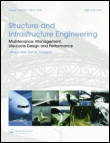
Structure and Infrastructure Engineering
Scope & Guideline
Exploring Innovations in Structure and Infrastructure
Introduction
Aims and Scopes
- Structural Performance Assessment:
Research on the evaluation of structural integrity, including fatigue analysis, seismic resilience, and damage detection methodologies for various types of structures. - Innovative Materials and Design Techniques:
Exploration of advanced materials and design methodologies, such as ultra-high-performance concrete and fiber-reinforced polymers, aimed at enhancing structural performance and durability. - Data-Driven Decision Making:
Utilization of data analytics, machine learning, and artificial intelligence to improve decision-making processes in infrastructure monitoring, maintenance, and management. - Environmental Impact and Sustainability:
Studies focused on the environmental impacts of structural engineering practices and the development of sustainable infrastructure solutions, including life-cycle assessments. - Risk and Reliability Analysis:
Probabilistic approaches to analyze risks associated with infrastructure systems, including vulnerability assessments under various hazards such as seismic events and climate change. - Digital Technologies in Infrastructure:
Integration of digital technologies, such as digital twins and smart monitoring systems, to enhance the assessment and management of infrastructure assets.
Trending and Emerging
- Machine Learning and AI Applications:
There is a growing trend in the application of machine learning and artificial intelligence for predictive maintenance, damage detection, and structural health monitoring, indicating a shift towards data-driven methodologies. - Resilience and Sustainability Studies:
Research focusing on the resilience of infrastructure systems against natural disasters and climate change impacts is increasingly popular, reflecting a societal need for more sustainable engineering practices. - Integration of Digital Twins:
The use of digital twin technology for real-time monitoring and assessment of infrastructure is gaining momentum, showcasing a trend towards leveraging digital tools for enhanced decision-making. - Advanced Non-Destructive Testing Techniques:
Emerging studies on innovative non-destructive testing methods, including the use of UAVs and advanced imaging techniques, are becoming more prevalent as they offer safer and more efficient inspection options. - Multi-Hazard Risk Assessments:
Research addressing the combined effects of multiple hazards (e.g., seismic, flooding) on infrastructure systems is on the rise, reflecting a broader understanding of risk in complex environments.
Declining or Waning
- Traditional Inspection Methods:
There is a noticeable reduction in studies focusing solely on conventional inspection techniques, as more advanced technologies like digital monitoring and machine learning gain traction. - Static Structural Analysis:
Research centered around static analysis methods is declining in favor of dynamic analysis techniques that better account for real-world conditions and loads. - Generalized Risk Assessments:
Broad, non-specific risk assessments are becoming less prominent compared to more targeted, quantitative risk analyses that utilize advanced modeling and simulation techniques.
Similar Journals

CANADIAN JOURNAL OF CIVIL ENGINEERING
Advancing Civil Engineering Knowledge Since 1971Canadian Journal of Civil Engineering, published by Canadian Science Publishing, serves as a premier platform for the dissemination of innovative research and development in the fields of civil and structural engineering, as well as environmental science. Established in 1971, this journal maintains a robust reputation, achieving a Q3 ranking in both civil engineering and general environmental science categories as of 2023. While it does not currently offer open access, the journal is accessible to a wide audience of researchers, professionals, and students who are keen to stay abreast of the latest advancements in civil engineering practices. With a significant number of yearly publications and a committed editorial board, the Canadian Journal of Civil Engineering contributes to the foundational knowledge and practical applications in the engineering community, thereby playing a critical role in addressing contemporary challenges in civil infrastructure and environmental sustainability.

Electronic Journal of Structural Engineering
Innovative Insights for Modern Engineering ChallengesThe Electronic Journal of Structural Engineering (ISSN: 1443-9255), published by EJSE INT LTD, serves as a vital platform for disseminating innovative research and developments in the field of structural engineering. Since its inception in 2001, the journal has evolved to embrace an Open Access model starting in 2022, ensuring that cutting-edge findings are freely accessible to researchers, professionals, and students worldwide. Housed within the reputable Department of Infrastructure Engineering at the University of Melbourne, Australia, the journal focuses on a wide range of topics related to civil and structural engineering, positioning itself within the Q4 category on the 2023 Scopus rankings. While its H-index and detailed scope data are currently unavailable, the journal's commitment to quality research is evident through its continuous publication and engagement with the global academic community. With significant implications for contemporary engineering practices, The Electronic Journal of Structural Engineering not only fosters scholarly discourse but also encourages practical applications of structural engineering advancements.
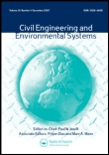
CIVIL ENGINEERING AND ENVIRONMENTAL SYSTEMS
Revolutionizing Civil Engineering Through ResearchCIVIL ENGINEERING AND ENVIRONMENTAL SYSTEMS, published by Taylor & Francis Ltd, is a pivotal academic journal dedicated to advancing the field of civil and structural engineering as well as environmental systems. With its ISSN 1028-6608 and E-ISSN 1029-0249, this journal serves as a crucial platform for disseminating high-quality research from 1998 through 2024. Recognized in the Scopus Ranks as #177 out of 379 in its category, equating to a 53rd percentile ranking, it holds a respectable Q3 category designation in Civil and Structural Engineering for 2023. The journal aims to bridge theoretical research and practical applications, showcasing innovative approaches and solutions to contemporary engineering challenges. Scattered across its pages are valuable insights from both emerging and established experts, making it an essential resource for researchers, professionals, and students seeking to enhance their understanding and impact within the civil engineering and environmental systems landscape. While it does not offer open access, the journal is part of a well-regarded publishing legacy, ensuring rigorous peer review and editorial standards that contribute meaningfully to academia and industry alike.
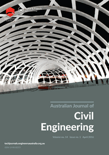
Australian Journal of Civil Engineering
Pioneering Insights for Modern Civil ChallengesThe Australian Journal of Civil Engineering, published by Taylor & Francis Ltd, stands as a pivotal platform within the field of civil and structural engineering. With an ISSN of 1448-8353 and an E-ISSN of 2204-2245, this journal consistently delivers high-quality research and innovative practices from both established and emerging scholars in the discipline. Recognized in the Q2 category for Civil and Structural Engineering in 2023, it holds a respectable position, ranking 146 out of 379 within its field according to Scopus, which places it in the 61st percentile. Converging valuable insights from 2011 through 2024, the journal encompasses a broad scope of topics, including sustainable infrastructure, innovative materials, and advanced construction techniques, thereby addressing contemporary challenges faced by engineering professionals. Though it is a traditional publication without open access options, the quality of the research featured ensures that it remains an essential resource for academics, practitioners, and students striving to enhance their knowledge and contribute to the dynamic field of civil engineering.
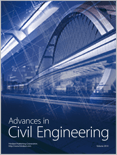
Advances in Civil Engineering
Pioneering Solutions for Sustainable DevelopmentAdvances in Civil Engineering is a leading peer-reviewed journal published by HINDAWI LTD, dedicated to advancing knowledge and innovation in the field of civil and structural engineering. Holding an esteemed Q2 ranking in the 2023 category for Civil and Structural Engineering, this journal serves as a vital platform for disseminating cutting-edge research and practical applications that address contemporary challenges in infrastructure development, sustainable design, and material science. Launched in 2008 and operating as an Open Access journal since 2009, it promotes the free exchange of ideas by ensuring that all articles are accessible to researchers, professionals, and students globally. The journal is also indexed in Scopus, ranking at #142 out of 379 in its category, situating it within the 62nd percentile of its peers. With a focus on interdisciplinary collaboration and innovative solutions, Advances in Civil Engineering contributes significantly to the ongoing evolution of engineering practices and education, making it an essential resource for anyone involved in or studying the ever-evolving field of civil engineering.

COMPUTER-AIDED CIVIL AND INFRASTRUCTURE ENGINEERING
Transforming Civil Engineering with Cutting-Edge TechnologyCOMPUTER-AIDED CIVIL AND INFRASTRUCTURE ENGINEERING, published by WILEY, stands as a leading journal in the domains of civil and structural engineering, computational theory, and computer-aided design since its inception in 1986. With an impressive ISSN of 1093-9687 and E-ISSN of 1467-8667, this esteemed UK-based journal holds a prestigious position in the academic community, reflected by its Q1 ranking in numerous relevant categories, including Civil and Structural Engineering and Computer Graphics as of 2023. The journal is renowned for promoting innovative research that utilizes computational techniques to solve complex engineering problems, making it an essential resource for researchers, professionals, and students alike. Despite its lack of open access options, the journal garners significant interest due to its rigorous peer-review process and high-impact articles, underlining its importance in the advancement of infrastructure engineering practices and technologies. With a Scopus ranking placing it among the top journals in various engineering and computer science fields, COMPUTER-AIDED CIVIL AND INFRASTRUCTURE ENGINEERING continues to foster knowledge and collaboration, ultimately contributing to the future of smart and resilient infrastructure development.
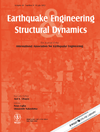
EARTHQUAKE ENGINEERING & STRUCTURAL DYNAMICS
Transforming theoretical insights into practical solutions.EARTHQUAKE ENGINEERING & STRUCTURAL DYNAMICS, published by Wiley, is a leading journal recognized for its significant contributions to the domains of civil and structural engineering, as well as geotechnical engineering and engineering geology. With an impressive Q1 ranking in multiple categories, including Civil and Structural Engineering, and an esteemed Scopus ranking placing it in the 82nd percentile, the journal serves as a premier platform for disseminating pioneering research and innovative methodologies related to earthquake engineering and dynamic structural analysis. Established in 1972, this journal boasts a comprehensive coverage of topics from theoretical developments to practical applications, making it an essential resource for researchers, industry professionals, and students eager to expand their understanding of seismic safety and structural resilience. Though it does not offer open access, the journal continues to be a cornerstone for scholarly communication within the earthquake engineering community, advancing knowledge that shapes better engineering practices worldwide.

Turkish Journal of Civil Engineering
Elevating Standards in Civil and Structural EngineeringWelcome to the Turkish Journal of Civil Engineering, a pioneering publication under the auspices of the TURKISH CHAMBER OF CIVIL ENGINEERS, dedicated to advancing the field of civil engineering and construction. With a focus on cutting-edge research and innovative practices, this journal seeks to provide a platform for scholars, professionals, and students to share their findings and insights within the sphere of civil and structural engineering. The journal is committed to open access, ensuring that research is readily available to a global audience. As it embarks on its journey from 2023 to 2024, it aims to enhance its reputation as a vital resource within the academic community, currently ranking in the 40th percentile for Building and Construction Engineering and 32nd for Civil and Structural Engineering in Scopus. We encourage contributions that push the boundaries of engineering knowledge, fostering collaboration and progress in this essential field.

Earthquakes and Structures
Advancing resilience through innovative seismic research.Earthquakes and Structures is a prestigious academic journal published by TECHNO-PRESS, dedicated to the field of Civil and Structural Engineering. Since its inception in 2010, this journal has provided a platform for innovative research and practical applications, addressing critical challenges related to seismic activities and their impact on infrastructure. With an ISSN of 2092-7614 and an E-ISSN of 2092-7622, it is indexed in top databases, reflecting its commitment to quality and relevance, as indicated by its Q3 quartile ranking in 2023. The journal encompasses a wide range of topics, from theoretical investigations to real-world case studies, appealing to researchers, professionals, and students alike. By fostering interdisciplinary collaboration and disseminating cutting-edge findings, Earthquakes and Structures plays an essential role in advancing knowledge and practices in earthquake engineering, enhancing global resilience against seismic threats.

JOURNAL OF COMPUTING IN CIVIL ENGINEERING
Advancing the Future of Civil Engineering Through Computing.JOURNAL OF COMPUTING IN CIVIL ENGINEERING is a leading publication in the field of civil and structural engineering, with a specific focus on the application of computer science techniques in civil engineering projects. Published by the ASCE - American Society of Civil Engineers, this esteemed journal has been at the forefront of innovative research since its inception in 1987 and continues to maintain high academic standards with a remarkable impact factor. Achieving a prestigious Q1 ranking in both Civil and Structural Engineering and Computer Science Applications, it holds a commendable position within the top percentiles of Scopus ranks, at 94th and 91st respectively. The journal serves as a vital resource for researchers, practitioners, and students aiming to explore the integration of computational technologies and methodologies in civil engineering practices. By publishing cutting-edge research, it aims to advance knowledge and foster collaboration within the field, contributing significantly to the development of efficient, sustainable, and innovative engineering solutions.